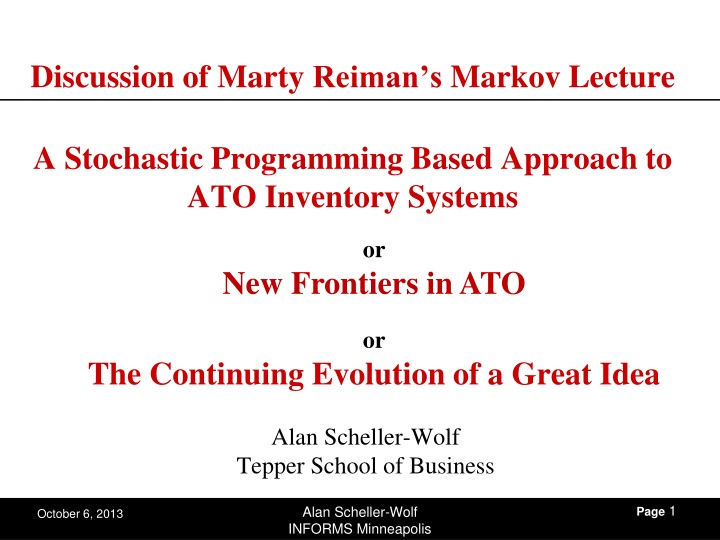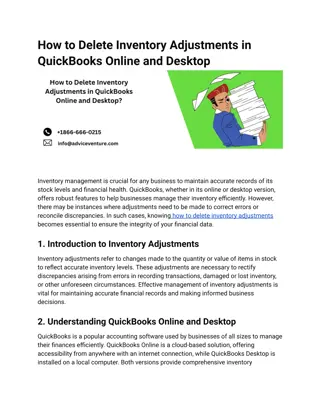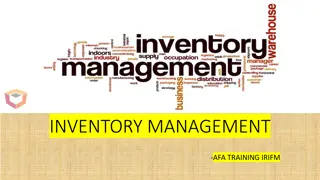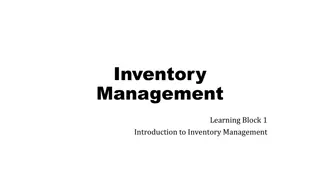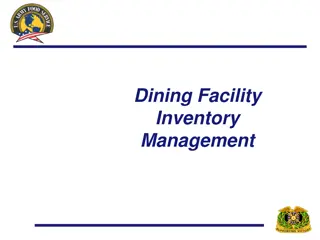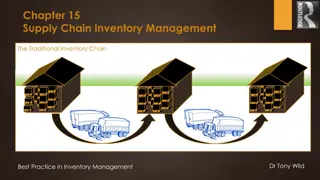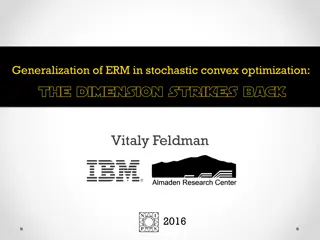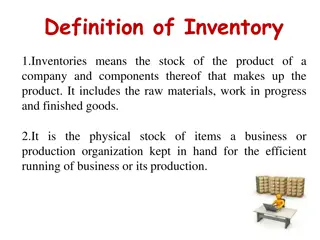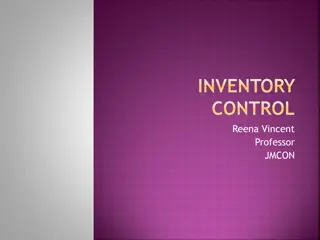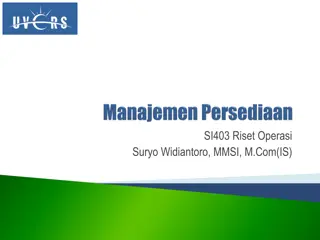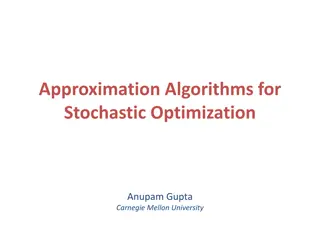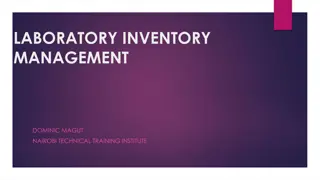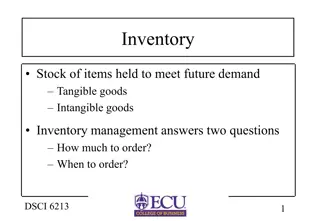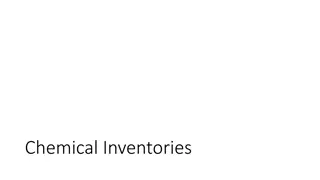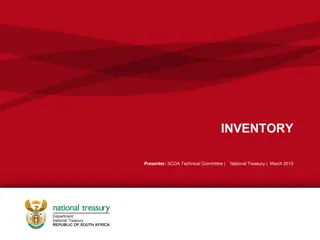Stochastic Programming in ATO Inventory Systems: Evolution and New Ideas
Marty Reiman's Markov lecture discussed a stochastic programming-based approach to ATO inventory systems, highlighting new frontiers and emerging ideas in the field. Structural and optimization results from selected literature were also reviewed, emphasizing the need for innovative approaches to inventory replenishment and allocation challenges. The presentation showcased the evolving landscape of ATO systems research, focusing on heavy traffic and stochastic programming as promising avenues for further exploration.
Download Presentation

Please find below an Image/Link to download the presentation.
The content on the website is provided AS IS for your information and personal use only. It may not be sold, licensed, or shared on other websites without obtaining consent from the author.If you encounter any issues during the download, it is possible that the publisher has removed the file from their server.
You are allowed to download the files provided on this website for personal or commercial use, subject to the condition that they are used lawfully. All files are the property of their respective owners.
The content on the website is provided AS IS for your information and personal use only. It may not be sold, licensed, or shared on other websites without obtaining consent from the author.
E N D
Presentation Transcript
Discussion of Marty Reimans Markov Lecture A Stochastic Programming Based Approach to ATO Inventory Systems or New Frontiers in ATO or The Continuing Evolution of a Great Idea Alan Scheller-Wolf Tepper School of Business Page 1 Alan Scheller-Wolf INFORMS Minneapolis October 6, 2013
Background for MyTalk Like Amy, and probably most of you, I have been familiar with Marty s asymptotic analysis of queueing networks for some time This is work I admired, but it was outside my primary stream of research Within the past few years, led by student interest, I have begun to work on ATO systems And whose work should I find dead center in in my research stream? Marty s! Page 2 Alan Scheller-Wolf INFORMS Minneapolis October 6, 2013
ATO: So whats the Problem? Inventory replenishment And allocation! Highly dependent n Components m Products Highly multi-dimensional And non-linear! Page 3 Alan Scheller-Wolf INFORMS Minneapolis October 6, 2013
Selected Literature (I) Structural Results: Special product architectures Markovian systems: Benjafaar and ElHafsi ( 06); ElHafsi ( 08); Nadar et al. ( 12) SP Analysis: DRW ( 10); Lu et al. ( 12); RW ( 12) Heavy Traffic: Plambeck and Ward ( 07, 08); RW ( 13) No-Holdback: Song and Zhao ( 2009), Lu et al. ( 2010) General results still lacking Page 4 Alan Scheller-Wolf INFORMS Minneapolis October 6, 2013
Selected Literature (II) Optimization Results: Approximations: Zhang ( 97); Song ( 98); Song and Yao ( 02); Cheng et al. ( 02); Kapucinski et al. ( 04); Lu and Song ( 05); van Jaarsveld et al. ( 11) SP Formulations: Swaminathan and Tayur ( 98); Akcay and Xu ( 04); Huang and de Kok ( 11), van Jaarsveld and S-W ( 13) Limited problem size. No guarantees* Page 5 Alan Scheller-Wolf INFORMS Minneapolis October 6, 2013
New Ideas are Needed The New Idea: Heavy Traffic Approach same hammer, new nail. The New Idea: Stochastic programming lower bound using full recourse Both ideas continue to evolve Page 6 Alan Scheller-Wolf INFORMS Minneapolis October 6, 2013
DRW 10 (I) Formulate ATO problem as two-stage SP, like NV Network Assume identical LT s Formulate second, Lower Bound SP by: Giving controller complete freedom to reallocate inventory over the leadtime demand Giving controller complete freedom to select initial backlog level Page 7 Alan Scheller-Wolf INFORMS Minneapolis October 6, 2013
DRW 10 (II) So What!? New LB: Obliterates dependence of ordering policy on the past, as controller has complete freedom to reallocate decisions Makes base-stock ordering optimal Forms universal lower bound over all policies Provides guidance for good (maybe optimal) policies for original problem Follow LB policy when possible A great idea Page 8 Alan Scheller-Wolf INFORMS Minneapolis October 6, 2013
But New LB: Limited to identical lead times Translating SP solution into actionable allocation policy can be difficult Page 9 Alan Scheller-Wolf INFORMS Minneapolis October 6, 2013
RW 12 See evolution of LB: Extended to non-identical leadtimes Creates (K+1) stage SP Verification Lemma: Provide sufficient conditions for when can track SP optimal policy Now can determine quality of solutions in some cases Page 10 Alan Scheller-Wolf INFORMS Minneapolis October 6, 2013
RW 13 Show sol of SP optimal under diffusion scaling Further evolution (reformulation) of LB: Finite parameters at optimality Actionable Backlog Targeting Heuristic Now can more easily implement policy implied by SP So what s next? Page 11 Alan Scheller-Wolf INFORMS Minneapolis October 6, 2013
The Next Stages in Evolution? Extend asymptotic results to unequal LT s and/or non-base stock replenishment Extend to industrial-sized problems Make applicable in practice Page 12 Alan Scheller-Wolf INFORMS Minneapolis October 6, 2013
What About Practice? (I) Companies use a variety of simplifying assumptions: Ignoring simultaneous stock outs (ISS): Wait time for product n is sum of wait time for components Simpler allocation rules: First come first served (FCFS); First Ready First Served (FRFS) Page 13 Alan Scheller-Wolf INFORMS Minneapolis October 6, 2013
What About Practice? (II) Van Jaarsveld and SW ( 13) provide two-stage SP algorithm for larger problems Tagged Job approach for waiting time Novel formulation of second-stage SAA High-quality asymptotic lower bound Limited to base stock + selected allocation rules Can DRW methodology be extended to practical- sized problems? Page 14 Alan Scheller-Wolf INFORMS Minneapolis October 6, 2013
Extending DRW to Larger Problems Requires workable solution to SP with unequal lead times (K+1) stages may be too many Requires efficient way to solve allocation problem for optimal backlog targets This appears very promising Page 15 Alan Scheller-Wolf INFORMS Minneapolis October 6, 2013
Conclusion ATO is classically difficult problem Requires new solution approaches Marty and co-authors continue to provide these As ideas evolve, new results become possible It is exciting to follow evolution and see where this leads Stay Tuned! Page 16 Alan Scheller-Wolf INFORMS Minneapolis October 6, 2013
